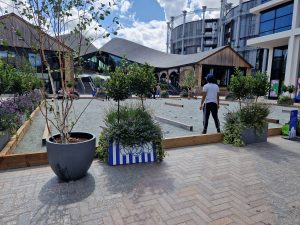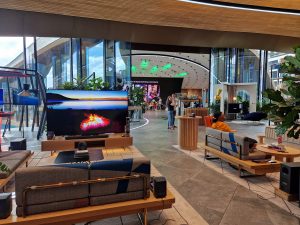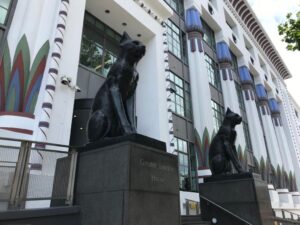Once a symbol of Victorian industrial prowess, this historical site has been deftly reimagined to accommodate a modern shopping centre, filled with eateries, bars, and various retail outlets. This fascinating transformation is precisely what we explore on our “All Change at Kings Cross” guided walk. If this piece piques your curiosity, we invite you to join us and experience it first-hand.
In 1999, a major turning point was the announcement of HS1, the high-speed rail link connecting Dover to London St Pancras. This wasn’t just a railway project; it was a catalyst for transformation. I remember selling my flat in Kensington to move closer to the action, eagerly anticipating the urban rejuvenation that would follow. Over two decades, I observed the metamorphosis of Kings Cross and St Pancras from industrial wastelands into flourishing cultural hubs.

To understand the gravity of this transformation, it’s important to delve into the history of the area. Developed around the 1850s, the regions north of Kings Cross and St Pancras Stations were primarily built to support the burgeoning industrial railways. Covering an expansive area of over 60 acres, this industrious space was a hive of activity, replete with rail lines, horses, and workmen tirelessly shifting goods carriages, aided by steam engines and capstans.
One of the architectural marvels of this time was the Coal Drop, designed by Lewis Cubitt, the same mind behind the later Kings Cross passenger station. The structure was essentially a long, narrow warehouse. Coal from northern England was brought in by rail carriages and sorted into small chambers, where it was graded and bagged. These bags were then dispatched into waiting horse-drawn carriages below, which in turn distributed coal across London.
So effective was this system that a second Western Coal Drop was constructed, designed to facilitate the transfer of coal to boats on the Regent’s Canal. By the late 19th century, however, these buildings had already started to serve other functions, transitioning over time to factories and even nightclubs in the 20th century.
 Come the 21st century, and the entire area was acquired by property developer Argent, who had a grand vision for this historical site. Local architect Thomas Heatherwick was commissioned to rejuvenate the original Coal Drop buildings while maintaining their historical essence. His addition of the ‘kissing roof,’ now home to the Samsung Showroom, is a notable feature that adds a contemporary flair to the Victorian structure.
Come the 21st century, and the entire area was acquired by property developer Argent, who had a grand vision for this historical site. Local architect Thomas Heatherwick was commissioned to rejuvenate the original Coal Drop buildings while maintaining their historical essence. His addition of the ‘kissing roof,’ now home to the Samsung Showroom, is a notable feature that adds a contemporary flair to the Victorian structure.
Today, Coal Drops Yard stands as an eclectic blend of the old and the new. It offers a myriad of experiences: from free pétanque sessions in the summer to an assortment of culinary delights, and even a knife shop named Kitchen Provisions where I’ve personally picked up three exquisite blades from Tokyo. Let’s not forget the floating bookshop, Word on the Water, which although not peddling coal, certainly adds a dash of literary culture to the locale.
If you’re intrigued by the astonishing transformation of this part of London, or perhaps new to the city and keen to discover how historic spaces can be adapted for contemporary use, I highly recommend booking a spot on our “All Change at Kings Cross” walking tour.
The evolution of Coal Drops Yard offers a riveting narrative on the successful redevelopment of a once-neglected industrial area into a thriving, people-friendly space. Whether you’re a longtime Londoner or a newcomer, one thing’s for certain: you will marvel at the change.




